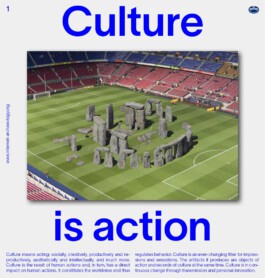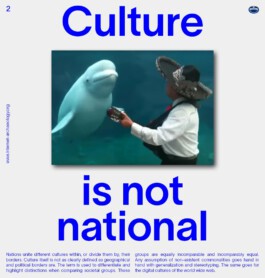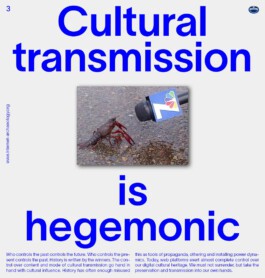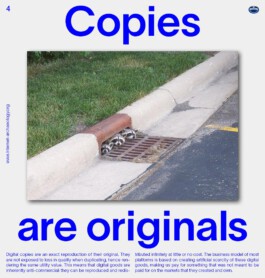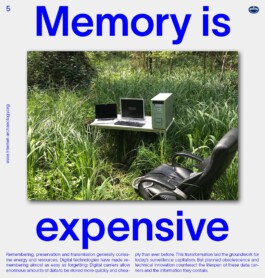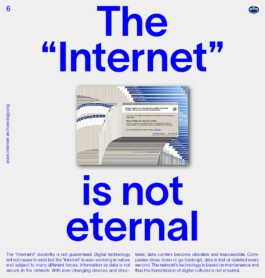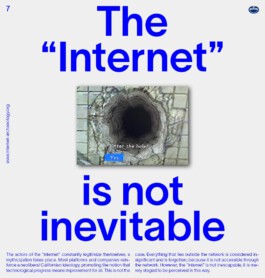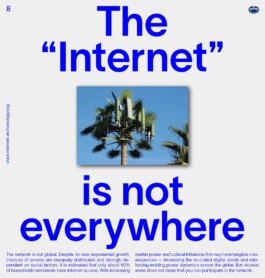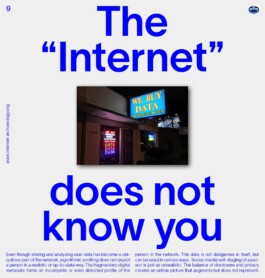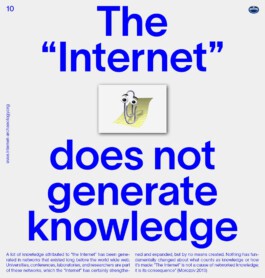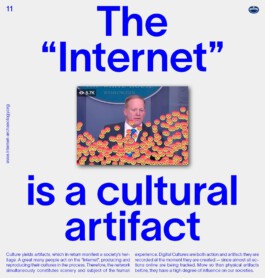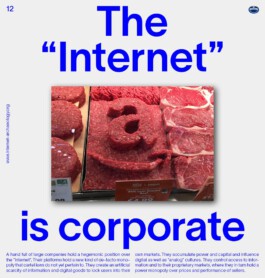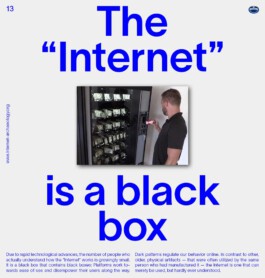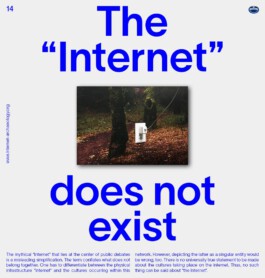This Manifesto explains the theories behind our work in a concise, memetic format. We invite you to download and share these images — they are designed to be spread and shared online.
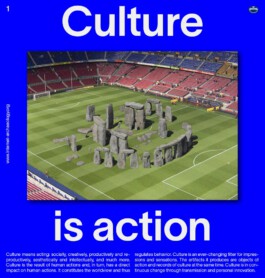
Culture is action
Culture means acting: socially, creatively, productively and reproductively, aesthetically and intellectually, and much more. Culture is the result of human actions and, in turn, has a direct impact on human actions. It constitutes the worldview and thus regulates behavior. Culture is an ever-changing filter for impressions and sensations. The artifacts it produces are objects of action and records of culture at the same time. Culture is in continuous change through transmission and personal innovation.
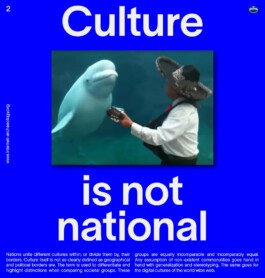
Culture is not national
Nations unite different cultures within, or divide them by, their borders. Culture itself is not as clearly defined as geographical and political borders are. The term is used to differentiate and highlight distinctions when comparing societal groups. These groups are equally incomparable and incomparably equal.
Any assumption of non-existent commonalities goes hand in hand with generalization and stereotyping. The same goes for the digital cultures of the world wide web.
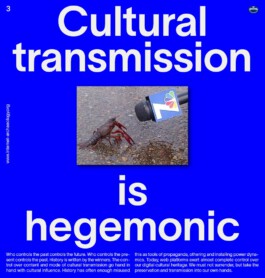
Cultural transmission is hegemonic
Who controls the past controls the future. Who controls the present controls the past. History is written by the winners. The control over content and mode of cultural transmission go hand in hand with cultural influence. History has often enough misused this as tools of propaganda, othering and installing power dynamics. Today, web platforms exert almost complete control over our digital cultural heritage. We must not surrender, but take the preservation and transmission into our own hands.
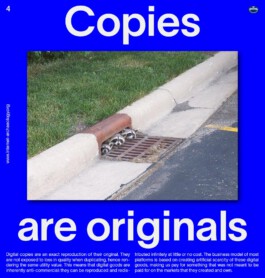
Copies are originals
Digital copies are an exact reproduction of their original. They are not exposed to loss in quality when duplicating, hence rendering the same utility value. This means that digital goods are inherently anti-commercial: they can be reproduced and redistributed infinitely at little or no cost. The business model of most platforms is based on creating artificial scarcity of these digital goods, making us pay for something that was not meant to be paid for on the markets that they created and own.
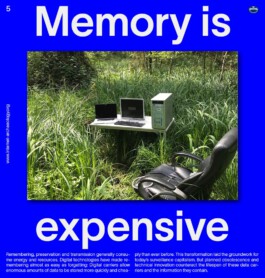
Memory is expensive
Remembering, preservation, and transmission generally consume energy and resources. Digital technologies have made remembering almost as easy as forgetting: Digital carriers allow enormous amounts of data to be stored more quickly and cheaply than ever before. This transformation laid the groundwork for today’s surveillance capitalism. But planned obsolescence and technical innovation counteract the lifespan of these data carriers and the information they contain.
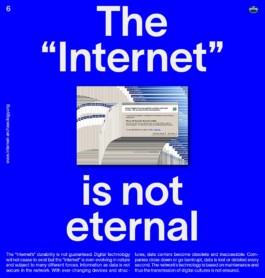
The “Internet” is not eternal
The “Internet’s” durability is not guaranteed. Digital technology will not cease to exist but the “Internet” is ever-evolving in nature and subject to many different forces. Information as data is not secure in the network. With ever-changing devices and structures, data carriers become obsolete and inaccessible. Companies close down or go bankrupt, data is lost or deleted every second. The network’s technology is based on maintenance and thus the transmission of digital cultures is not ensured.
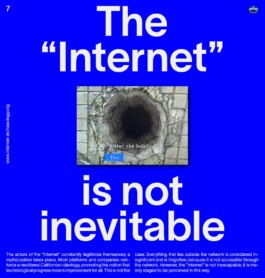
The “Internet” is not inevitable
The actors of the "Internet" constantly legitimize themselves; a mythicization takes place. Most platforms and companies reinforce a neoliberal Californian ideology, promoting the notion that technological progress means improvement for all. This is not the case. Everything that lies outside the network is considered insignificant and is forgotten, because it is not accessible through the network. However, the "Internet" is not inescapable, it is merely staged to be perceived in this way.
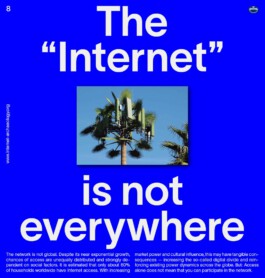
The “Internet” is not everywhere
The network is not global. Despite its near exponential growth, chances of access are unequally distributed and strongly dependent on social factors. It is estimated that only about 60% of households worldwide have Internet access. With increasing market power and cultural influence, this may have tangible consequences — increasing the so-called digital divide and reinforcing existing power dynamics across the globe. But: Access alone does not mean that you can participate in the network.
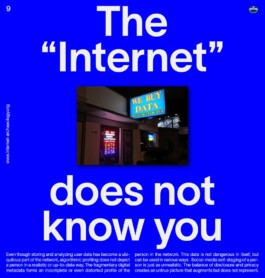
The “Internet” does not know you
Even though storing and analyzing user data has become a ubiquitous part of the network, algorithmic profiling does not depict a person in a realistic or up-to-date way. The fragmentary digital metadata forms an incomplete or even distorted profile of the person in the network. This data is not dangerous in itself but can be used in various ways. Social-media self-staging of a person is just as unrealistic. The balance of disclosure and privacy creates an untrue picture that augments but does not represent.
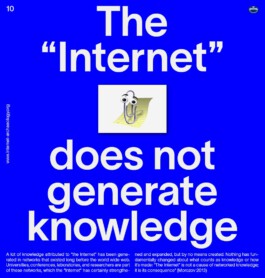
The “Internet” does not generate knowledge
A lot of knowledge attributed to “the Internet” has been generated in networks that existed long before the world wide web. Universities, conferences, laboratories, and researchers are part of these networks, which the “Internet” has certainly strengthened and expanded, but by no means created. Nothing has fundamentally changed about what counts as knowledge or how it’s made: “The Internet” is not a cause of networked knowledge; it is its consequence” (Morozov 2013)
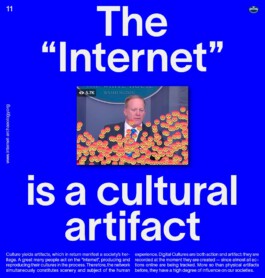
The “Internet” is a cultural artifact
Culture yields artifacts, which in return manifest a society’s heritage. A great many people act on the “Internet”, producing and reproducing their cultures in the process. Therefore, the network simultaneously constitutes scenery and subject of the human experience. Digital Cultures are both action and artifact: they are recorded at the moment they are created — since almost all actions online are being tracked. More so than physical artifacts before, they have a high degree of influence on our societies.
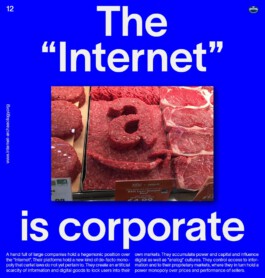
The “Internet” is corporate
A hand full of large companies hold a hegemonic position over the "Internet”. Their platforms hold a new kind of de-facto monopoly that cartel laws do not yet pertain to. They create an artificial scarcity of information and digital goods to lock users into their own markets. They accumulate power and capital and influence digital as well as “analog” cultures. They control access to information and to their proprietary markets, where they in turn hold a power monopoly over prices and performance of sellers.
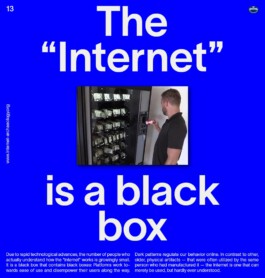
The “Internet” is a black box
Due to rapid technological advances, the number of people who actually understand how the “Internet” works is growingly small. It is a black box that contains black boxes: Platforms work towards ease of use and disempower their users along the way. Dark patterns regulate our behavior online. In contrast to other, older, physical artifacts — that were often utilized by the same person who had manufactured it — the Internet is one that can merely be used, but hardly ever understood.
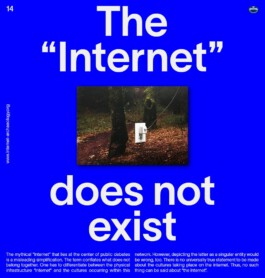
The “Internet” does not exist
The mythical “Internet” that lies at the center of public debates is a misleading simplification. The term conflates what does not belong together. One has to differentiate between the physical infrastructure “Internet” and the cultures occurring within this network. However, depicting the latter as a singular entity would be wrong, too. There is no universally true statement to be made about the cultures taking place on the internet. Thus, no such thing can be said about “the Internet”.
